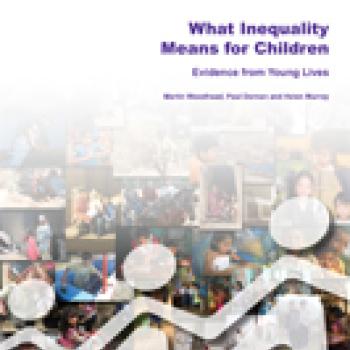
The new Young Lives synthesis paper on inequality was launched at an event hosted by DFID in London on 29 January 2013.
Understanding how poverty and inequalities affect is children central to understanding the impact of the MDGs and development of the post-2015 agenda. Key successes, notably in primary enrolment and access to basic services, mask differences in the speed of progress for particular social groups. The post-2015 agenda offers an important opportunity to draw attention to policy to benefit the poorest children.
In this presentation, the Young Lives team looked at the ways multiple inequalities interact in their impact on children's development and affect their life-chances. Tracking children over 15 years enables us to see how gender-based differences evolve over the life-course, highlighting trigger points that shape different opportunities for girls and boys. We also see that while stunting is still widespread, there is evidence of partial recovery for some children. This reinforces the conclusion that investment in early childhood is essential, but shows that later interventions to support older children are also important. We also look at equality of access, school quality and outcomes across different school systems to review the opportunities available for children from different backgrounds and to look at what is it that enables some school systems to be more equalising than others.
Presentations
What Inequality Means for Children: Evidence from Young Lives, Professor Martin Woodhead, Young Lives / The Open University
Home and School Disadvantage and How Children Learn: Are some education systems more equal than others?, Caine Rolleston, Young Lives / University of Oxford
Developing Effective Policy for Children: Evidence from longitudinal research, Professor Jo Boyden, Young Lives / University of Oxford


The new Young Lives synthesis paper on inequality was launched at an event hosted by DFID in London on 29 January 2013.
Understanding how poverty and inequalities affect is children central to understanding the impact of the MDGs and development of the post-2015 agenda. Key successes, notably in primary enrolment and access to basic services, mask differences in the speed of progress for particular social groups. The post-2015 agenda offers an important opportunity to draw attention to policy to benefit the poorest children.
In this presentation, the Young Lives team looked at the ways multiple inequalities interact in their impact on children's development and affect their life-chances. Tracking children over 15 years enables us to see how gender-based differences evolve over the life-course, highlighting trigger points that shape different opportunities for girls and boys. We also see that while stunting is still widespread, there is evidence of partial recovery for some children. This reinforces the conclusion that investment in early childhood is essential, but shows that later interventions to support older children are also important. We also look at equality of access, school quality and outcomes across different school systems to review the opportunities available for children from different backgrounds and to look at what is it that enables some school systems to be more equalising than others.
Presentations
What Inequality Means for Children: Evidence from Young Lives, Professor Martin Woodhead, Young Lives / The Open University
Home and School Disadvantage and How Children Learn: Are some education systems more equal than others?, Caine Rolleston, Young Lives / University of Oxford
Developing Effective Policy for Children: Evidence from longitudinal research, Professor Jo Boyden, Young Lives / University of Oxford


